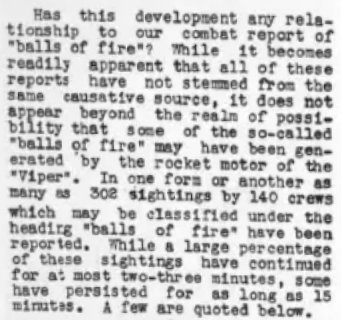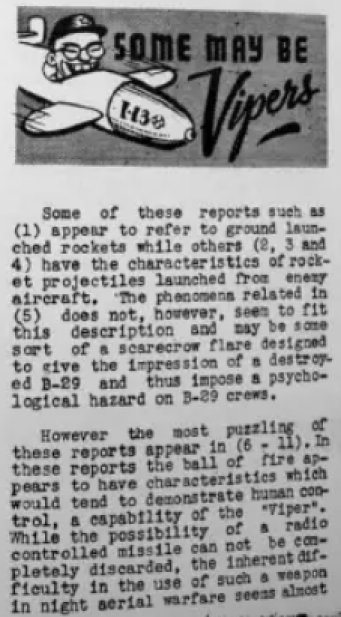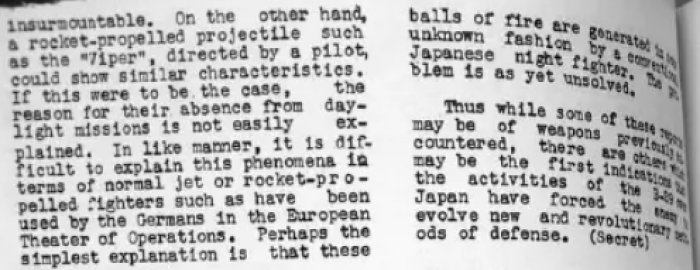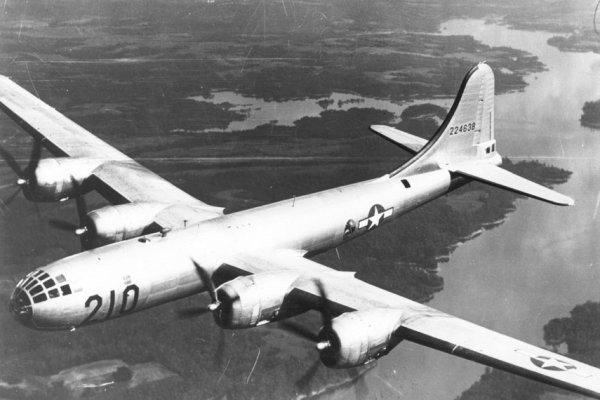ACUFO-1945-00-00-JAPAN-1
As my catalog shows, in 1945, the crews of American B-29 bombers of the XXIst Bomber Command who carried out day and night raids on Japan often reported seeing “balls of fire” whose nature sometimes remains very uncertain.
The uncertain nature of these “balls of fire” was the subject of an article on April 26, 1945 in the secret bulletin of the American Air Intelligence of the XXIst Bomber Command, Air Intelligence Report.
The article on these “fireballs” was preceded by an article on the piloted rocket-propelled flying bomb “Baka”, aka “Viper” that the Japanese used for “Kamikaze” missions. The article on the balls of fire was dealing with the question of whether “balls of fire” could be explained by these craft, but the conclusion remained undecided.
The article included 12 cases of “balls of fire” reports, without date or location reference, but coming from reports of the XXIst Bomber Command B-29 bombers air raid missions over Japan in 1945. One of the sample reports said:
“Several enemy aircraft observed to have two bright lights which flowed like fire, one located on either side of engine (if it were single engine plane). Lights were whitish red, estimated to be five feet apart. Not believed to be exhaust flames since they appeared to be turned off and on.”
| Date: | 1945 |
|---|---|
| Time: | ? |
| Duration: | ? |
| First known report date: | April 26, 1945 |
| Reporting delay: | Days, months. |
| Country: | Japan |
|---|---|
| State/Department: | |
| City or place: |
| Number of alleged witnesses: | ? |
|---|---|
| Number of known witnesses: | ? |
| Number of named witnesses: | 0 |
| Reporting channel: | Intelligence report. |
|---|---|
| Visibility conditions: | Probable night. |
| UFO observed: | Yes. |
| UFO arrival observed: | ? |
| UFO departure observed: | ? |
| UFO action: | Flow like fire, intermittently. |
| Witnesses action: | |
| Photographs: | No. |
| Sketch(s) by witness(es): | No. |
| Sketch(es) approved by witness(es): | No. |
| Witness(es) feelings: | ? |
| Witnesses interpretation: | ? |
| Sensors: |
[X] Visual: 1 or more.
[ ] Airborne radar: [ ] Directional ground radar: [ ] Height finder ground radar: [ ] Photo: [ ] Film/video: [ ] EM Effects: [ ] Failures: [ ] Damages: |
|---|---|
| Hynek: | NL |
| Armed / unarmed: | Armed, 12 Browning M2 12,7 mm machine guns. |
| Reliability 1-3: | 2 |
| Strangeness 1-3: | 2 |
| ACUFO: | Unidentified, insufficient information. |
[Ref. aaf2:] U.S. ARMY AIR FORCES:
After a presentation of the “Baka” aka “Viper” piloted rocket suicide bomb (see my Discussion section), a chapter title “Are these fireballs?” expanded on whether this craft was the “balls of fire” reported by B-29 pilots in the Pacific in 1944 - 1945.
12 examples of reports of “balls of fire” are cited; unfortunately, generally without date or location or information on the involved unit.
The introduction read:

|
Has this development [the “Baka” aka “Viper”] any relationship to our combat reports of “balls of fire”? While it becomes readily apparent that all of these reports have not stemmed from the same causative source, it does not appear beyond the realm of possibility that some of the so-called “balls of fire” may have been generated by the rocket engine of the “Viper”. In one form or another as many as 302 sightings by 140 crews which may be classified under the heading of “balls of fire” have been reported. While a large percentage of these sightings have continued for at most two-three minutes, some have persisted for as long as 15 minutes. A few are quoted below.
Quoted below were indeed 12 reports summaries, including:
“Several enemy aircraft observed to have two bright lights which flowed like fire, one located on either side of engine (if it were single engine plane). Lights were whitish red, estimated to be five feet apart. Not believed to be exhaust flames since they appeared to be turned off and on.”
The reports were followed by these comments:

|
Some of these reports such as (1) appear to refer to ground launched rockets while others (2, 3 and 4) have the characteristics of rocket projectiles launched from enemy aircraft. The phenomena related in (5) does not, however, seem to fit this description and may be some sort of a scarecrow flare designed to give the impression of a destroyed B-29 and thus impose a psychological hazard on B-29 crews.
However the most puzzling of these reports appear in (6 - 11). In these reports the ball of fire appears to have characteristics which would tend to demonstrate human control, a capacity of the “Viper”. While the possibility of a radio controlled missile ca not be completely discarded, the inherent difficulty in the use of such a weapon in night aerial warfare seems almost

|
insurmountable. On the other hand, a rocket-propelled projectile such as the “Viper”, directed by a pilot, could show similar characteristics.
If this were to be the case, the reason for their absence from daytime missions is not easily explained. In like manner, it is difficult to explain this phenomena in terms of normal jet or rocket-propelled fighters such as have been used by the Germans in the European Theater of Operations. Perhaps the simplest explanation is that these balls of fire are generated in an unknown fashion by a conventional Japanese night fighter. The problem is as yet unsolved.
Thus while some of these reports may be of weapons previously encountered, there are others which may be the first indications that the activities of the B-29 have forced the enemy to evolve new and revolutionary methods of defense. (Secret)
There is no information about the observing aircraft in the report; but obviously it was discussing the sightings made by the B-29's over Japan.
The Boeing B-29 “Superfortress” was the heaviest bomber of the U.S. Army Air Forces, used in operations from May 8, 1944 and on. Its maximum speed was 574 km/h.
Its defensive armament was 12 Browning M2 12.7 mm machine guns.

|

|
A number of the reports of 1944 - 1945 over Japan by aircrews of the B-29's are headscratching events, very difficult to assess.
One reason is brevity. Details are missing, such as angular sizes, or movements.
Sometimes, it is very tempting to think that what was seen must be among the various “fireworks” of Japanese anti-aicraft defenses: ground-to-air flak or rockets, air-to-air rockets, phosphorus bombs dropped by the Japanese aircraft above and ahead of the B-29's, etc.
In this case, one would think “rockets”, but the Air Intelligence did not seem to think so.
We read that the flowing lights came from “enemy aircraft”, with “one located on either side of engine”; but there is a problem when the report says “(if it were single engine plane)”. It it was not determined that these “enemy aircraft” were single engine or twin engine planes, then, it is almost as if these “enemy planes” were “guessed” rather than seen.
Back then, Air Intelligence may have suspected these “enemy aircraft” were jet aircraft. We now know that the Japanese air forces had no jet planes in operations in WWII. The Air Inetelligence, it this report, wondered whether the reported phenomena they listed could be caused by the “Baka” rocket-propelled piloted suicide bombs. But here, it is not possible anyway because the “Baka” only had one rocket engine, and the carrier planes were only able to drop one “Baka”.
The report also says that the lights were “Not believed to be exhaust flames since they appeared to be turned off and on.” This would exclude air-to-air rockets.
And lastly, as in all the odd reports over Japan in 1944 and 1945, it this was some unknown Japanese weapon, againm there is no sign that it attacked the B-29's.
In the end, I have no idea what this could have been.
Unidentified, insufficient information.
* = Source is available to me.
? = Source I am told about but could not get so far. Help needed.
| Main author: | Patrick Gross |
|---|---|
| Contributors: | None |
| Reviewers: | None |
| Editor: | Patrick Gross |
| Version: | Create/changed by: | Date: | Description: |
|---|---|---|---|
| 0.1 | Patrick Gross | June 30, 2024 | Creation, [aaf2]. |
| 1.0 | Patrick Gross | June 30, 2024 | First published. |